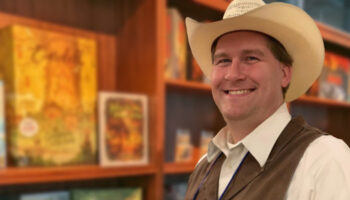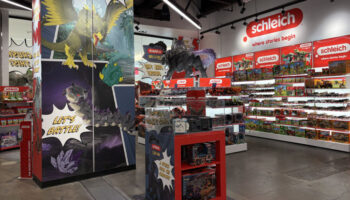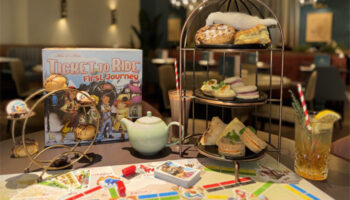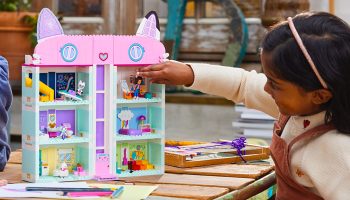“Innovation relies on bringing fresh voices into our community”: Lee Allentuck on inventors, inspiration and the importance of connecting people

Lee, it’s always lovely to catch up. Some people fall into the industry; others seek out a career in toys. How did you get started?
The funny thing is that my first real job during high school was at an independent toy store. I wore the little apron and acted like a knew what I was talking about, but I was always into toys and loved play. That said, I didn’t set out to work in toys. I’ve always been a brands and marketing person, but I love innovation and the creative process.
In my pre-toy career I started out in sports marketing and entertainment. I did a lot of small business PR in Washington, DC where I grew up. I was the press secretary for the PGA when they came through town. I worked with The Ringling Bros. and Barnum & Bailey Circus managing clown college try-outs. It was a wild variety of fun projects.
That makes sense.
Ha! There’s plenty of strings you could pull on with that! But I eventually went to the world’s largest PR firm where I was doing consumer tech PR, but it wasn’t until we moved up here to New England that I got into toys because an opportunity opened up at Hasbro Games. It was two miles down the road and I ended up working on licensed games as well managing the puzzle category and homegrown IPs. It was a weird transition from mobile telecoms to the largest games manufacturer in the world – but it was fun and I loved it. I could take all the skills from marketing, branding and PR, and apply it to product development.
Now, you do branding, marketing and product development for different toy and game companies – and you also look after inventor relations for clients like Melissa & Doug and Blue Marble. Did you have much exposure to inventors back then at Hasbro?
Yes, it was directly linked actually. I was part of the evaluation group. Back then, Mike Hirtle and Mike Gray were the inventor relations guys – legends of the industry. They would bring ideas in, and I’d evaluate the ones that were relevant to my portfolio. So, I was on the back-end, but I quickly appreciated what the Mikes were doing, and what the inventor community were doing.
Sometimes at big companies, you’re so focused on things internally that you don’t get the breath of fresh air that comes through engaging with external innovators. So even though I was internally facing, I’d always look externally for inspiration.
How did you add that inventor relations string to your bow?
When I moved to LEGO, I headed up outbound licensing and was working with lots of external companies. A strength of mine was being able to work with outside innovators while still keeping things on-brand – and that’s really hard to do with a brand like LEGO! I’d also have chats with inventors during my time there and when I left, I reached out to the innovation group to see if I could help LEGO connect more with inventors; I even convinced them to come to ChiTAG – now People of Play – for the first time. It ended up being a challenging time for that initiative due to lots of transition at the company, but it set me up to get more involved in inventor relations down the line.
How do you navigate handling inventor relations for several clients?
Well, I think I’ve found a cool niche for the inventor community in what I do – this being talking to small, medium and some large companies that don’t have an inventor relations resource internally. It’s not an easy thing to start because there’s so many legalities and a huge network to engage with. You also want to make sure you’re controlling the process and doing it right. You want to do it in a way that protects the company but also protects the inventors. There has to be a lot of trust.
My strongest asset is my network and relationships. I can bring those to a Melissa & Doug, or a Blue Marble, or a Gameboard, and it opens up exciting opportunities for those clients, but also for the inventor community.
There’s sometimes a bit of scepticism to combat from the inventors because there’s an agency model out there that takes a cut of ideas that are licensed. I don’t take anything off the back end, there’s no royalty; I’m on a retainer with the companies. It means inventors can come into these conversations via a relationship with me and then develop a fruitful relationship with these companies.
What are some of the key ingredients to successful inventor relations?
From an inventors’ perspective, you must think about the company and its brands. You need to put yourself in the shoes of the people in-house and really know your stuff when it comes to their audience and how they reach them. If I’m a pre-school company that focuses on developmental toys, don’t try and pitch your collectibles. Be professional; come prepared. You don’t have to have all the bells and whistles – show us the play-pattern, show us the detail and where it could go as a product or experience, show us why kids will have fun with it… We really like to hear the insights on how you developed it and why you think this is either on-trend or a unique experience. Communicate why it’s a good idea for our brand to be doing your concept. That’s really important and can be very compelling in a pitch. You don’t need a fancy video. Keep it simple.
On the inventor relations side, you have to put your feet in the inventors’ shoes, ask important questions and be respectful of what the inventor has put into their ideas. It’s also critical to give usable feedback so they can improve how they pitch to you in the future. If it’s not right for the brand, say so. If it’s been done before, let them know. And be sure to provide the feedback in a timely manner so they can move onto other opportunities. By doing this, you’re building trust and they’ll want to pitch to you again in the future.
And how important is it for you engage with new inventors and expand the current pool of talent?
It’s hugely important. I love talking with new inventors. Innovation relies on bringing new people and fresh voices into our community. You can also unearth inventors with areas of expertise that we need. I love talking to them, giving feedback and connecting them with helpful figures in the industry. The more we share contacts and connections, the better we all are for it. The best part of my job is connecting people.
For any inventors reading, what are the likes of Blue Marble, Melissa & Doug and Gameboard looking for concept-wise?
Well, they all have broad wish lists so it’s tough to boil it down, but they all want something that fit into their portfolio – and something that can expand it. If anyone is interested in pitching to these companies, I’m happy to provide the wish list information directly at [email protected].
Great! I also wanted to touch upon the work you do with local schools around these robotics challenges. What can you tell me about that?
There are three things that I’m seriously passionate about outside of work. One is my family, two is drums and three is robotics. The robotics thing started with my son. When he was in fifth grade I started looking for a STEM programme that he could do to learn coding. We found FIRST LEGO League robotics and we loved doing it. We spent so much time together with his friends and it was a rollercoaster of emotions – losing, winning, crashing, breaking and rebuilding. It really helped to set him off into a career in electrical engineering.
When he got to high school, we started this robotics programme – again with FIRST Robotics. It ties nicely into what I do for a living in that it’s about innovation, creativity and bringing ideas to life. There’s so much failure, learning and emotion in creating something and putting it out there to compete. Whether it wins or loses, you feel like you’ve accomplished something.
I’m just finishing my 10th year doing it. We’re now a non-profit organisation called LongMetal Robotics and we’re expanding to middle and elementary schools. We run STEM nights and a robotics camp. It’s cool – we’re building robots! What’s cooler than that!?
I can’t argue with you there! And here is a link if people want to know more: https://www.longmetal.org. Now, before I let you go, I wanted to ask what the most underrated project or product launch you’ve worked on is? We can give it some love here!
Wow! There’s so many cool things I’ve worked on that died on the vine. I worked with on a project for Subbuteo. We had so much fun working on that but it didn’t make it to market. There was also an inventor item that came in at Hasbro that stole my heart. I think we called it Yetis Vs Ninjas. It was ridiculous and it didn’t get over the line, but we loved it. Sometimes, it’s just about timing.
Last question! How do you have ideas? What fuels your creativity?
I watch a lot of movies and TV shows and that inspires me – especially old ones. My son and I watched the American Film Institute’s Top 100 Movies over the last year. Some of them are terrible and others are hard to find, but it was inspiring because you learn the origins of so much in pop culture. We also watched all the Fast & Furious and the Sharknado series to break-up the serious dramas.
They weren’t in the AFI’s Top 100 Movies list?
They are a list unto themselves and it amazes me that Vin Diesel hasn’t been nominated yet! I also find drumming fuels my creativity. I’m never going to be a Dave Grohl, but I thought I’d take on a new challenge at my age and feed my brain. It’s hard and frustrating, but it’s kept me motivated and creative.
Lee, this has been fun! Let’s tie-in again soon.
–
To stay in the loop with the latest news, interviews and features from the world of toy and game design, sign up to our weekly newsletter here





















